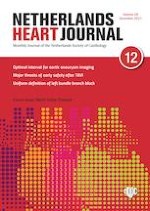-
Nearly half of all ascending aortic aneurysms do not grow over time.
-
Female sex and aortic regurgitation predispose to more rapid aortic growth.
-
Triennial imaging follow-up suffices for ascending aortic aneurysms with diameters between 40 and 49 mm.
Introduction
Methods
Study population
Data collection and image analysis
Statistical analysis
Results
Baseline characteristics
TAV (n = 275) | BAV (n = 57) | p-value | |
|---|---|---|---|
Age (years) | 65.9 (58.4–71.7) | 52.4 (42.4–59.8) | <0.001 |
Sex (female) | 65 (23.6%) | 19 (33.3%) | 0.125 |
Height (cm) | 174.8 ± 8.6 | 177.2 ± 9.6 | 0.07 |
Weight (kg) | 81.8 ± 14.8 | 83.6 ± 14.8 | 0.39 |
BMI (kg/m2) | 26.6 ± 3.9 | 26.6 ± 4.1 | 0.94 |
BSA (m2) | 2.0 ± 0.2 | 2.0 ± 0.2 | 0.19 |
Hypertension | 210 (76.4%) | 25 (43.9%) | <0.001 |
Dyslipidaemia | 121 (44.0%) | 10 (17.5%) | <0.001 |
Diabetes | 15 (5.5%) | 3 (5.3%) | 0.95 |
AS ≥ moderate | 19 (6.9%) | 16 (28.1%) | <0.001 |
AR ≥ moderate | 27 (9.8%) | 9 (15.8%) | 0.19 |
CABG | 25 (9.1%) | 1 (1.8%) | 0.06 |
CVA/TIA | 35 (12.7%) | 6 (10.5%) | 0.65 |
Malignancy | 33 (12.0%) | 6 (10.5%) | 0.75 |
Haemodialysis | 2 (0.7%) | 0 | 0.52 |
Aneurysm growth
Univariable | Multivariable | |||
|---|---|---|---|---|
B | p-value | B | p-value | |
Age (years) | −0.003 | 0.108 | ||
Sex (female) | 0.134 | 0.007 | 2.142 | 0.033 |
Hypertension | 0.002 | 0.964 | ||
Dyslipidaemia | 0.030 | 0.492 | ||
Valve morphology (tricuspid) | 0.013 | 0.819 | ||
AS ≥ moderate | −0.016 | 0.817 | ||
AR ≥ moderate | 0.270 | <0.001 | 3.987 | <0.001 |
Baseline diameter (mm) | −0.011 | 0.118 | ||
Surgical repair
Univariable | Multivariable | |||
|---|---|---|---|---|
B | p-value | B | p-value | |
Age (years) | −0.031 | 0.046 | 0.024 | 0.578 |
Sex (male) | 0.623 | 0.159 | ||
Hypertension | 0.003 | 0.996 | ||
Dyslipidaemia | −0.089 | 0.839 | ||
AS ≥ moderate | 0.891 | 0.098 | ||
AR ≥ moderate | 1.609 | 0.001 | 2.432 | 0.080 |
Surgical threshold (≥55 mm) | −1.179 | 0.009 | −5.610 | 0.004 |
Baseline diameter (mm) | 0.302 | <0.001 | 1.130 | <0.001 |
Growth rate (mm/year) | 3.992 | <0.001 | 11.299 | <0.001 |
Optimal imaging interval
Current diameter | Accuracy (%) | Reduction of imaging studiesa (%) | |||
|---|---|---|---|---|---|
40–44 mm | 45–49 mm | 50–54 mm | |||
Protocol 1 | Two-yearly | Two-yearly | Annually | 100 | 17.8 |
Protocol 2 | Two-yearly | Two-yearly | Two-yearly | 53.3 | 43.4 |
Protocol 3 | Three-yearly | Two-yearly | Annually | 100 | 20.6 |
Protocol 4 | Three-yearly | Three-yearly | Annually | 100 | 29.9 |
Current diameter | Accuracy (%) | Reduction of imaging studiesa (%) | ||
|---|---|---|---|---|
40–44 mm | 45–49 mm | |||
Protocol 1 | Two-yearly | Annually | 100 | 8.0 |
Protocol 2 | Two-yearly | Two-yearly | 33.3 | 44.4 |
Protocol 3 | Three-yearly | Annually | 100 | 16.0 |
